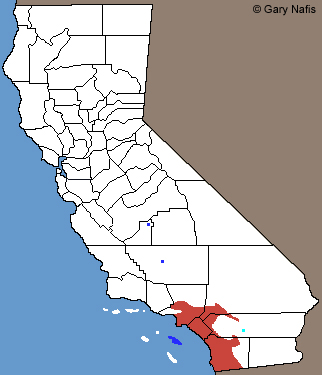|
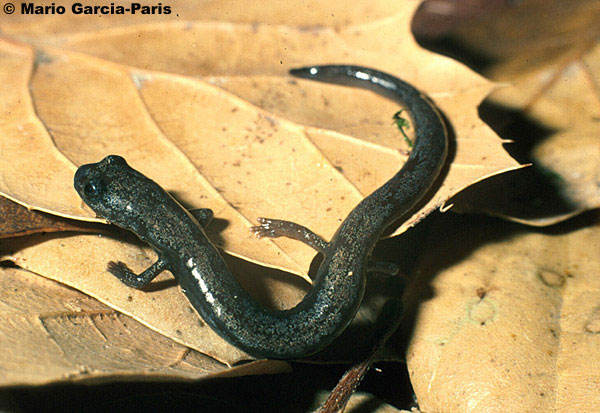 |
Adult, Riverside County
© Mario Garcia-Paris |
 |
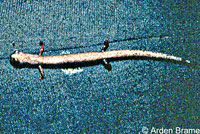 |
|
| Adult © Mario Garcia-Paris |
This is the holotype (the animal designated as the type specimen for the original publication describing the new form of salamander), © Arden Brame, (courtesy of Harold De Lisle.) |
|
| |
|
|
| Habitat |
 |
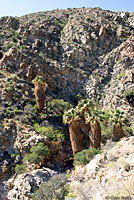 |
 |
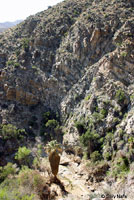 |
 |
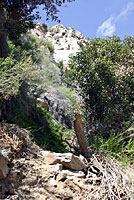 |
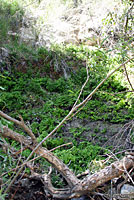 |
 |
|
| Palm Canyon habitat, access courtesy of Eddie Konno CDFW |
In the spring of 2006 I was allowed to hike down into a protected canyon to assist the California Department of Fish and Game in a survey for Desert Slender Salamanders. When we arrived, we could see where water from an unusually heavy rain storm the previous October had poured down the cliff above the canyon and washed away a great deal of vegetation, including the area where the salamanders have been found. In a casual search under available cover, we were unable to locate any salamanders, but Desert Slender Salamanders might continue to survive in this location since they have been subjected to such flooding over the millennia.
|
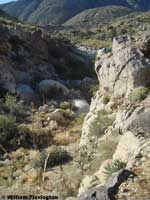 |
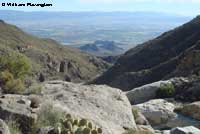 |
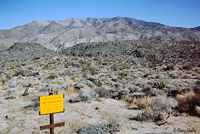 |
Known locality for B. m. aridus in Guadalupe Canyon.
© William Flaxington |
Guadalupe Canyon.
© William Flaxington |
Desert surrounding the restricted canyon habitat, Riverside County.
|
| |
|
|
| Description |
| |
| Size |
Adults are 1 1/4 - 2 inches long (3.1-5 cm) from snout to vent.
|
| Appearance |
A fairly broad-headed and long-legged slender salamander with a relatively short tail and 16-19 costal grooves (usually 18).
There are 3.5 - 6.5 costal folds between adpressed limbs.
Short limbs, a narrow head, long slender body, very long tail, and conspicuous costal and caudal grooves give this species the worm-like appearance typical of most Slender Salamanders.
There are four toes on the front and hind feet, which is also typical of Slender Salamanders.
(Other California salamanders have five toes on the hind feet.) |
| Color and Pattern |
Adults have a pale grey, white or pink coloration dorsally due to a suffusion of silver or brassy flecks.
The underside of the tail is paler than the dark belly.
Young lack the speckling of the adults.
|
| Life History and Behavior |
A member of family Plethodontidae, the Plethodontid or Lungless Salamanders.
Plethodontid salamanders do not breathe through lungs. They conduct respiration through their skin and the tissues lining their mouth. This requires them to live in damp environments on land and to move about on the ground only during times of high humidity. (Plethodontid salamanders native to California do not inhabit streams or bodies of water but they are capable of surviving for a short time if they fall into water.)
Plethodontid salamanders are also distinguished by their nasolabial grooves, which are vertical slits between the nostrils and upper lip that are lined with glands associated with chemoreception.
All Plethodontid Salamanders native to California lay eggs in moist places on land.
The young develop in the egg and hatch directly into a tiny terrestrial salamander with the same body form as an adult.
(They do not hatch in the water and begin their lives as tiny swimming larvae breathing through gills like some other types of salamanders.) |
| Activity |
Although it occurs amidst one of the harshest climates in the world, B. aridus has been found during every month of the year - even in the middle of summer - which indicates that they are active whenever surface conditions are favorable.
|
| Defense |
Most of the specimens of this salamander exhibited a defensive behavior unique to slender salamanders when they were uncovered in the field. They coiled their body while elevating their tail. The combination of these two behaviors has not been observed in any other species of slender salamander.
|
| Diet and Feeding |
| Most likely eats a variety of small invertebrates. Salamanders have been observed feeding at night capturing small insect with their projectile tongue. |
| Reproduction |
Reproduction is terrestrial.
Little is known of the reproductive habits of this salamander.
|
| Eggs |
Females of other Batrachoseps species lay eggs in moist places on land.
It is presumed that eggs are laid in deep moist limestone crevices. |
| Young |
Young develop completely in the egg and hatch fully formed.
|
| Habitat |
In Hidden Palm Canyon, B. aridus inhabits a moist cliff and the talus beneath it, as well as associated springs at the oasis. The cliff has a year-round seep covered in Maidens-Hair Fern, and shaded by California Fan Palms and Willow trees.
The habitat surrounding the canyon is dry Sonoran Desert scrub.
Salamander sites are shaded and do not get much direct sunlight.
|
| Geographical Range |
Endemic to California.
B. aridus has one of the most limited geographic distributions of any North American amphibian.
For more than 50 years after its discovery in 1969 it was only known from two localities on the east slope of the Santa Rosa Mountains: Hidden Palm Canyon (a tributary to Deep Canyon) at an elevation of 2,800 ft., (850 m) and Guadalupe Canyon, about 4.5 miles - 8 km (by air) to the south-east. The numbers of salamanders found at a given locality within Guadalupe Canyon have been fewer than those found in Hidden Palm Canyon. According to a personal communication with Robert Hansen in 12/24 a new population was recently discovered by USGS personnel, which he was able to photograph for his 2025 field guide.
|
 |
| Notes on Taxonomy |
Discovered in 1969 and described as a full species, Batrachoseps aridus.
----------------------------------------------------------------------------------------------------------------------------------------------------------------------
Based on a recommendation by Wake and Jockusch, B.aridus was synonymized with Batrachoseps major in 2002.
----------------------------------------------------------------------------------------------------------------------------------------------------------------------
In 2000, using DNA studies, Jockusch and Wake * reduced Batrachoseps aridus to a subspecies of Batrachoseps major - B. m. aridus, making the rest of B. major, the subspecies B. major major.
Some texts do not use this taxonomy because B. aridus is a federally-protected endangered species.
----------------------------------------------------------------------------------------------------------------------------------------------------------------------
Full Species
Amphiaweb (1/25) treat B. aridus as a full species for conservation reasons, with this taxonomic note:
"Wake and Jockusch (2000, Biol Plethodontid Salamanders) & Jockusch and Wake (2002, Biol J Linn Soc) treat Batrachoseps aridus as a subspecies of Batrachoseps major. Because of ongoing conservation concerns in California state, AmphibiaWeb recognizes it as a full species following the Department of Fish and Wildlife, CA. Martinez-Solano et al. (2012 Molecular Phylogenetics and Evolution 63: 131-149) has continued its study."
Hansen and Shedd (2025) chose to treat B. aridus as a full species "...given its distinctive ecology, morphology, and mtDNA sequence differences, and position as a geographic outlier to the range of B. major."
----------------------------------------------------------------------------------------------------------------------------------------------------------------------
"Jockusch et al. (2020, PeerJ 8: e9599) gave a detailed phylogeographic estimate of B. major and the southern clade of B. nigriventris based on mitochondrial and nuclear evidence. Several species including B. major comprise deeply divergent genetic lineages that do not correspond to existing taxonomy. They retained B. m. aridus, but additional revision is needed."
(Nicholson, K. E. (ed.). 2025 SSAR Scientific and Standard English Names List)
----------------------------------------------------------------------------------------------------------------------------------------------------------------------
Here's a Diagram of the Batrachoseps Complex showing the relationships between species.
----------------------------------------------------------------------------------------------------------------------------------------------------------------------
Alternate and Previous Names (Synonyms)
Batrachoseps major aridus - Desert Slender Salamander (2025 SSAR Scientific and Standard English Names List)
Batrachoseps major aridus - Desert Slender Salamander (Stebbins 2003, 2012)
Batrachoseps aridus - Desert Slender Salamander (Robert W. Hansen and David B. Wake in Lanoo, 2005)
Batrachoseps aridus - Desert Slender Salamander (Brame 1970, Stebbins 1985)
|
| Conservation Issues (Conservation Status) |
The habitat of this salamander is very fragile. The Hidden Palm Canyon site is a State Ecological Preserve that can only be entered with a permit. This salamander is currently protected by California law.
A U.S. Fish and Wildlife Service study published June 17, 2009 reported that no salamanders have been found during CDFG searches since 1996, but these searches have only been casual cursory searches of surface cover, because a more thorough search would damage the fragile habitat. Since the salamanders most likely remain deep in limestone crevices by day, emerging at night to feed, a night survey would be the best search method. The study also mentions that a 1976 storm washed out an estimated 25 percent of the salamander's habitat. The limestone sheets and talus where the salamanders were most commonly found were completely eroded away and the canyon floor was eroded down 6-10 feet. The most recent sighting in 1996 was in a nearly-vertical bank of ferns. Continuing 5-Year Reviews in 2014 and 2020 report the same, including the failure of seven night surveys between 2017 and 2019 to find any salamanders.
The 2009 study also mentions that the salamander habitat could have been damaged if the hydrology of the area was modified by highway construction that resulted in more damaging flows during storms. Climate change could also be causing increased evaporation leaving less moisture for salamander habitat. Introduced water-hungry Tamarisk trees may also be a threat to the Guadalupe Canyon population.
|
|
| Taxonomy |
| Family |
Plethodontidae |
Lungless Salamanders |
Gray, 1850 |
| Genus |
Batrachoseps |
Slender Salamanders |
Bonaparte, 1841 |
Species
|
aridus |
Desert Slender Salamander |
Brame, 1970 |
|
Original Description |
Brame, Arden. H., Jr. "A new species of Batrachoseps (slender salamander) from the desert of southern
California." Contributions in Science. Los Angeles County Museum, 200. 1970
|
|
Meaning of the Scientific Name |
Batrachoseps - Greek - batrachos = amphibian, frog + seps = lizard — describes lizard-like appearance
aridus - probably refers to the arid desert habitat surrounding the type locality oasis
from Scientific and Common Names of the Reptiles and Amphibians of North America - Explained © Ellin Beltz
|
|
Similar Neighboring Salamanders |
Batrachoseps major - Southern California (Garden) Slender Salamander
|
|
More Information and References |
California Department of Fish and Wildlife
AmphibiaWeb
Brame, A. H., Jr. "A new species of Batrachoseps (slender salamander) from the desert of southern California." Contributions in Science. Los Angeles County Museum, 200. 1970
Thelander, C. G., ed., 1994. Life on the Edge: A Guide to California's Endangered Natural Resources Volume I: Wildlife. Biosystems Books, Santa Cruz, California.
Hansen, Robert W. and Shedd, Jackson D. California Amphibians and Reptiles. (Princeton Field Guides.) Princeton University Press, 2025.
Stebbins, Robert C., and McGinnis, Samuel M. Field Guide to Amphibians and Reptiles of California: Revised Edition (California Natural History Guides) University of California Press, 2012.
Stebbins, Robert C. California Amphibians and Reptiles. The University of California Press, 1972.
Flaxington, William C. Amphibians and Reptiles of California: Field Observations, Distribution, and Natural History. Fieldnotes Press, Anaheim, California, 2021.
Nicholson, K. E. (ed.). 2025. Scientific and Standard English Names of Amphibians and Reptiles of North America North of Mexico, with Comments Regarding Confidence in Our Understanding. Ninth Edition. Society for the Study of Amphibians and Reptiles. [SSAR] 87pp.
Samuel M. McGinnis and Robert C. Stebbins. Peterson Field Guide to Western Reptiles & Amphibians. 4th Edition. Houghton Mifflin Harcourt Publishing Company, 2018.
Stebbins, Robert C. A Field Guide to Western Reptiles and Amphibians. 3rd Edition. Houghton Mifflin Company, 2003.
Behler, John L., and F. Wayne King. The Audubon Society Field Guide to North American Reptiles and Amphibians. Alfred A. Knopf, 1992.
Robert Powell, Roger Conant, and Joseph T. Collins. Peterson Field Guide to Reptiles and Amphibians of Eastern and Central North America. Fourth Edition. Houghton Mifflin Harcourt, 2016.
Powell, Robert., Joseph T. Collins, and Errol D. Hooper Jr. A Key to Amphibians and Reptiles of the Continental United States and Canada. The University Press of Kansas, 1998.
American Museum of Natural History - Amphibian Species of the World 6.2
Bartlett, R. D. & Patricia P. Bartlett. Guide and Reference to the Amphibians of Western North America (North of Mexico) and Hawaii. University Press of Florida, 2009.
Bishop, Sherman C. Handbook of Salamanders. Cornell University Press, 1943.
Lannoo, Michael (Editor). Amphibian Declines: The Conservation Status of United States Species. University of California Press, June 2005.
Petranka, James W. Salamanders of the United States and Canada. Smithsonian Institution, 1998.
* Jockusch, Elizabeth and David Wake. Detecting Species Borders Using Diverse Data Sets. Pp. 95-119. In Bruce, Jaeger and Houck (editors). The Biology of Plethodontid Salamanders. Kluwer Academic/Plenum Publishers, New York, 2000.
Desert slender salamander (Batrachoseps major aridus) 5-Year Review. U.S. Fish and Wildlife Service Carlsbad Fish and Wildlife Office, Carlsbad, Calfornia June 17, 2009.
|
|
|
The following conservation status listings for this animal are taken from the July 2025 State of California Special Animals List and the July 2025 Federally Listed Endangered and Threatened Animals of California list (unless indicated otherwise below.) Both lists are produced by multiple agencies every year, and sometimes more than once per year, so the conservation status listing information found below might not be from the most recent lists, but they don't change a great deal from year to year.. To make sure you are seeing the most recent listings, go to this California Department of Fish and Wildlife web page where you can search for and download both lists:
https://www.wildlife.ca.gov/Data/CNDDB/Plants-and-Animals.
A detailed explanation of the meaning of the status listing symbols can be found at the beginning of the two lists. For quick reference, I have included them on my Special Status Information page.
If no status is listed here, the animal is not included on either list. This most likely indicates that there are no serious conservation concerns for the animal. To find out more about an animal's status you can also go to the NatureServe and IUCN websites to check their rankings.
Check the current California Department of Fish and Wildlife sport fishing regulations to find out if this animal can be legally pursued and handled or collected with possession of a current fishing license. You can also look at the summary of the sport fishing regulations as they apply only to reptiles and amphibians that has been made for this website.
A note on the Federally Listed Endangered and Threatened Animals of California list states that the State of California lists this salamander as a full species - Batrachoseps aridus, but the 7/03/23 Special Animals List shows it as the subspecies Batrachoseps major aridus.
|
| Organization |
Status Listing |
Notes |
| NatureServe Global Ranking |
G4
T1 |
Species Apparently Secure.
Subspecies Critically Imperiled |
| NatureServe State Ranking |
S1 |
Critically Imperiled |
| U.S. Endangered Species Act (ESA) |
FE |
Listed as Endangered 6/04/73
"Listed by the State of California as Batrachoseps aridus and originally listed by the USFWS as B. aridus. USFWS 5-year review refers to B. major aridus". |
| California Endangered Species Act (CESA) |
SE |
Listed as Endangered 6/27/71
|
| California Department of Fish and Wildlife |
None |
|
| Bureau of Land Management |
None |
|
| USDA Forest Service |
None |
|
| IUCN |
None |
|
|
|
|
